Eco-Friendly Living Solutions from Lida Group Combine Prefabricated Container Building with Sustainable Design Principles
2025-Oct-17 17:02:30
By Admin
1. Introduction
The global construction industry stands at a critical crossroads, grappling with mounting environmental pressures and the urgent need to transition toward sustainability. According to the International Energy Agency (IEA), the construction sector accounts for approximately 36% of global energy-related carbon dioxide emissions and consumes over 50% of the world’s extracted raw materials annually. Traditional construction methods, characterized by on-site waste, high energy consumption, and prolonged project timelines, have become increasingly incompatible with global climate goals, such as the Paris Agreement’s target of limiting global warming to 1.5°C above pre-industrial levels. In this context, innovative building solutions that prioritize resource efficiency, waste reduction, and low carbon footprints have emerged as essential drivers of industry transformation.
Prefabricated container buildings, derived from repurposed shipping containers, have gained significant traction in recent years as a viable alternative to conventional construction. Shipping containers, once retired from maritime use, represent a largely untapped resource—each container is constructed from high-strength steel, capable of withstanding extreme weather conditions and offering a durable, modular foundation for building. By repurposing these containers, the construction industry can reduce reliance on virgin materials, cut down on manufacturing-related emissions, and minimize construction waste. However, the true potential of prefabricated container buildings lies in their integration with sustainable design principles—a synergy that Lida Group, a leading global provider of integrated building solutions, has mastered to deliver comprehensive eco-friendly living solutions.
Lida Group, with decades of experience in modular construction and a strong commitment to environmental stewardship, has redefined the possibilities of prefabricated container living. The company’s approach goes beyond mere repurposing; it combines the structural advantages of shipping containers with a holistic sustainable design framework, encompassing energy efficiency, water conservation, eco-friendly material usage, and ecological harmony. This article explores how Lida Group’s innovative solutions address key environmental challenges in construction, examines the technical and design elements that underpin its success, showcases real-world project 案例,and evaluates the broader impact of these solutions on the global push for sustainable living.
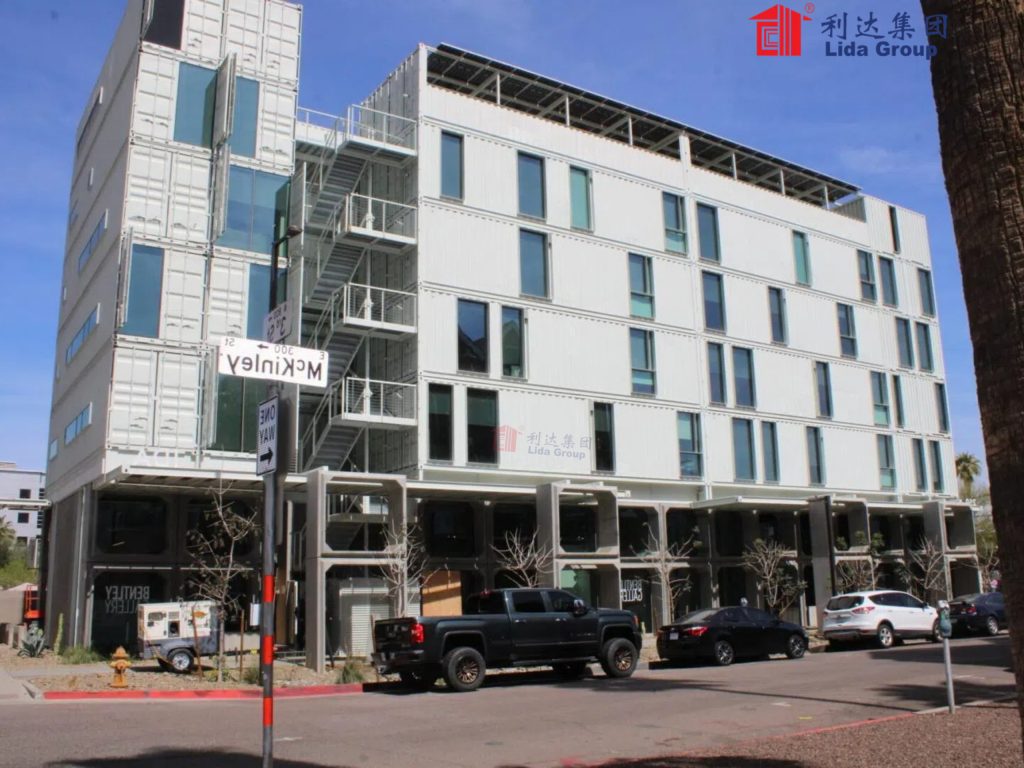
2. Overview of Lida Group: A Leader in Sustainable Modular Construction
Founded in the early 1990s, Lida Group has grown from a regional construction firm to a global player specializing in prefabricated and modular building solutions. Headquartered in China, the company operates across six continents, with manufacturing facilities, project offices, and distribution networks in over 30 countries. Lida Group’s core mission—“Building a Greener Future Through Innovation”—guides every aspect of its operations, from research and development (R&D) to project delivery and post-occupancy support.
What sets Lida Group apart in the modular construction sector is its end-to-end approach. Unlike many competitors that focus solely on container modification, Lida Group offers integrated solutions, including design customization, off-site manufacturing, on-site assembly, and sustainable technology integration. The company’s team of architects, engineers, and sustainability experts collaborates closely with clients—ranging from governments and NGOs to commercial developers and residential customers—to tailor solutions that meet specific functional needs while adhering to the highest environmental standards.
Lida Group’s commitment to sustainability is reflected in its certifications and industry recognition. The company has achieved ISO 14001 Environmental Management System certification, a global standard for environmental performance, and its projects have consistently met or exceeded international green building benchmarks, such as LEED (Leadership in Energy and Environmental Design) and BREEAM (Building Research Establishment Environmental Assessment Method). Additionally, Lida Group has been recognized by the United Nations Environment Programme (UNEP) for its contributions to circular economy practices in the construction sector, particularly through its container repurposing initiatives.
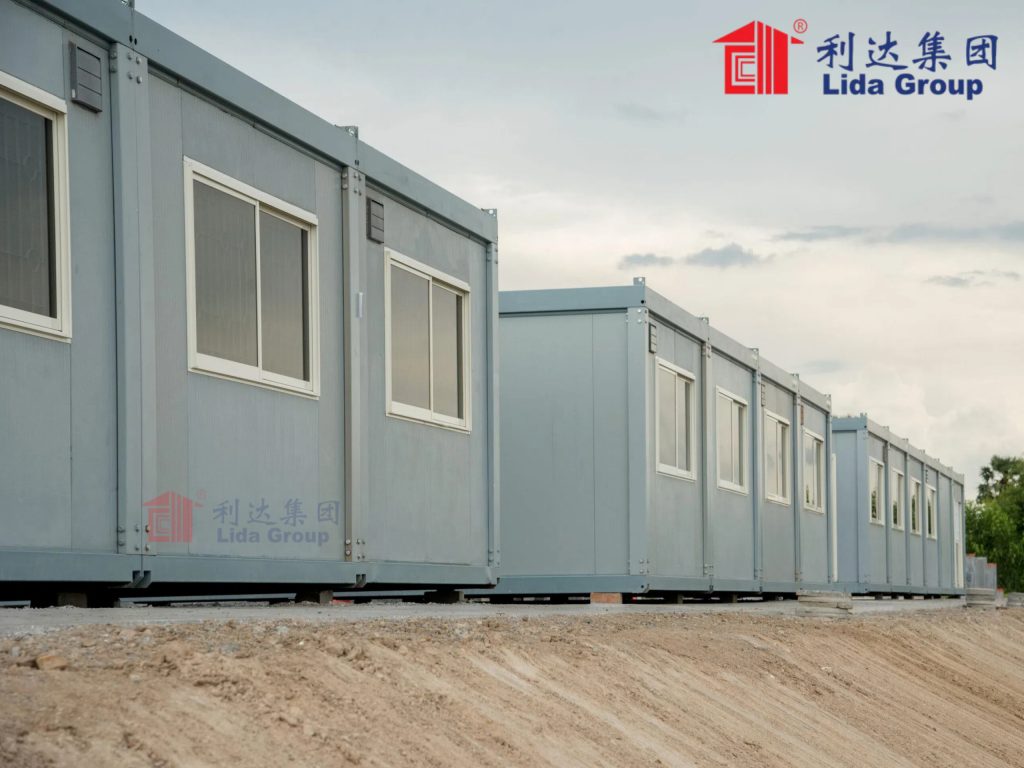
3. The Environmental Foundation of Prefabricated Container Buildings
Before delving into Lida Group’s sustainable design integration, it is critical to understand the inherent environmental benefits of prefabricated container buildings—benefits that serve as the foundation for the company’s eco-friendly solutions.
3.1 Reducing Waste Through Container Repurposing
Each year, an estimated 10-15 million shipping containers reach the end of their maritime service life globally. Without repurposing, these containers often end up in landfills or are melted down for scrap—a process that consumes energy and generates carbon emissions. Lida Group’s use of retired shipping containers diverts this waste from landfills, extending the lifecycle of a durable material. According to the company’s sustainability reports, repurposing one 20-foot shipping container saves approximately 1.5 tons of virgin steel, 3,000 liters of water (used in steel production), and reduces carbon emissions by 2.5 tons compared to manufacturing new steel for building frames.
3.2 Minimizing On-Site Construction Waste
Traditional construction generates an average of 2-3 tons of waste per 100 square meters of building area, with much of this waste consisting of unused materials, cut-off scraps, and debris. Prefabricated container buildings, by contrast, are primarily manufactured off-site in Lida Group’s controlled factory environments. This off-site production allows for precise material measurement, standardized cutting, and reuse of excess materials—resulting in a 70-80% reduction in on-site waste. For example, in a residential project in Southeast Asia, Lida Group’s off-site manufacturing process generated only 0.3 tons of waste per 100 square meters, a fraction of the waste produced by nearby traditional construction sites.
3.3 Lowering Energy Consumption in Construction
On-site construction is energy-intensive, requiring fuel-powered machinery (such as cranes, excavators, and generators) and extended project timelines. Lida Group’s prefabricated container buildings significantly reduce construction energy use in two key ways: shorter on-site timelines and efficient off-site manufacturing. Factory production leverages electric machinery and centralized energy systems (often powered by renewable sources), while on-site assembly typically takes 50-70% less time than traditional construction. A 2023 study by the Modular Building Institute found that Lida Group’s container projects consume an average of 40% less energy during construction compared to conventional buildings of the same size.
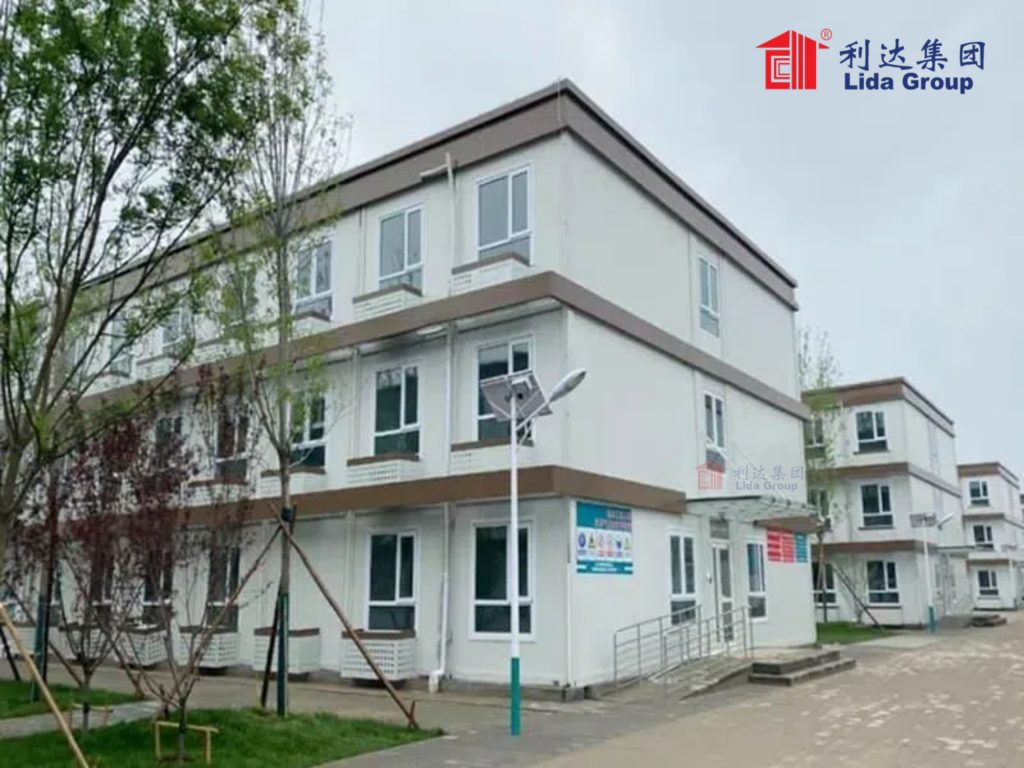
4. Lida Group’s Integration of Sustainable Design Principles
While prefabricated container buildings offer inherent environmental benefits, Lida Group elevates these solutions by embedding sustainable design principles into every stage of the building lifecycle. The company’s design framework focuses on four core pillars: energy efficiency, water conservation, eco-friendly material selection, and ecological integration.
4.1 Energy Efficiency: Powering Buildings with Renewable Sources and Smart Design
Energy consumption accounts for a significant portion of a building’s environmental impact, both during operation and construction. Lida Group addresses this by combining renewable energy systems with passive design strategies to minimize reliance on fossil fuels.
4.1.1 Solar Energy Integration
Nearly all of Lida Group’s container buildings are equipped with solar photovoltaic (PV) systems, tailored to the local climate and energy needs. The company uses high-efficiency monocrystalline solar panels, which offer a conversion efficiency of 22-24%—higher than the industry average of 18-20%. These panels are installed on the roofs of container buildings, which are angled to maximize sun exposure (e.g., 30-45 degrees in temperate regions). For off-grid projects, such as rural housing in Africa, Lida Group integrates solar batteries (lithium-ion or lead-acid) with a storage capacity of 5-10 kWh, ensuring a reliable energy supply even during cloudy days.
In a 2022 project in Kenya, Lida Group constructed 50 container homes for a rural community, each equipped with a 1.5 kW solar PV system and a 7 kWh battery. The homes generate enough energy to power lighting, a small refrigerator, and a mobile phone charger—meeting the community’s basic energy needs without relying on diesel generators or grid electricity. According to post-project data, the solar systems reduced the community’s carbon emissions by 1.2 tons per household annually.
4.1.2 Passive Energy Strategies
In addition to renewable energy, Lida Group incorporates passive design elements to reduce energy demand. These include:
- Thermal Insulation: Containers are lined with high-performance insulation materials, such as rock wool or extruded polystyrene (XPS), which have a thermal conductivity (k-value) of 0.03-0.04 W/mK. This insulation prevents heat transfer, keeping interiors cool in hot climates and warm in cold climates. For example, in desert regions, Lida Group adds an extra layer of reflective insulation to the container walls, reducing heat gain by up to 50%.
- Natural Ventilation: Container buildings are designed with cross-ventilation systems, including operable windows and roof vents. In tropical regions, the company installs wind catchers—tall, narrow structures that draw cool air into the building and expel hot air—reducing the need for air conditioning by 60-70%.
- Daylighting: Large windows and skylights are integrated into container designs to maximize natural light, reducing the need for artificial lighting during the day. Lida Group uses low-emissivity (low-e) glass, which reflects infrared radiation while allowing visible light to pass through, further improving energy efficiency.
4.2 Water Conservation: Reducing Consumption and Maximizing Reuse
Water scarcity is a growing global challenge, with over 2 billion people living in water-stressed regions. Lida Group’s container buildings address this by incorporating water-saving technologies and recycling systems.
4.2.1 Rainwater Harvesting
Most of Lida Group’s projects include rainwater harvesting systems, which collect and store rainwater from the container roofs. The systems consist of gutters, downspouts, filters (to remove debris), and storage tanks (with capacities ranging from 500 to 5,000 liters, depending on the project size). In areas with high rainfall, such as Southeast Asia, these systems can meet up to 40% of a building’s non-potable water needs (e.g., irrigation, toilet flushing, and cleaning).
In a commercial project in Thailand—a shopping center constructed from 30 shipping containers—Lida Group installed a 10,000-liter rainwater harvesting system. The collected water is used to irrigate the center’s vertical gardens and flush toilets, reducing the building’s municipal water consumption by 35% annually.
4.2.2 Low-Flow Fixtures and Greywater Recycling
To reduce potable water use, Lida Group equips container buildings with low-flow plumbing fixtures, including low-flow toilets (using 4-6 liters per flush, compared to 10-15 liters for conventional toilets) and low-flow showerheads (flow rate of 6-8 liters per minute, vs. 15-20 liters for standard models). These fixtures alone reduce water consumption by 30-40%.
For larger projects, such as student dormitories or office buildings, Lida Group integrates greywater recycling systems. Greywater—wastewater from sinks, showers, and washing machines—is treated using biological filters and disinfection systems (e.g., UV light) to remove contaminants. The treated water is then reused for irrigation or toilet flushing. In a 2021 dormitory project in India (housing 200 students), the greywater recycling system saved 20,000 liters of potable water per month.
4.3 Eco-Friendly Material Selection: Prioritizing Sustainability and Health
The materials used in building construction have a significant impact on the environment and indoor air quality. Lida Group adheres to a strict material selection policy, prioritizing recycled, renewable, and low-VOC (volatile organic compound) materials.
4.3.1 Recycled and Renewable Materials
- Structural Materials: Beyond the repurposed steel containers, Lida Group uses recycled steel for additional structural components (e.g., support beams) and recycled aluminum for window frames. These materials reduce the demand for virgin metal production, which is energy-intensive and emits high levels of carbon.
- Interior Finishes: Flooring is often made from bamboo (a fast-growing renewable resource) or recycled vinyl, while wall panels are constructed from recycled paperboard or agricultural waste (e.g., wheat straw board). These materials are not only sustainable but also lightweight, reducing the overall weight of the container building and simplifying transportation.
- Insulation: As mentioned earlier, Lida Group uses rock wool insulation (made from recycled basalt) or cellulose insulation (made from recycled newspaper), both of which have low environmental footprints and excellent thermal performance.
4.3.2 Low-VOC Materials
To ensure healthy indoor air quality, Lida Group avoids materials that release harmful VOCs, such as conventional paints, adhesives, and sealants. Instead, the company uses low-VOC or zero-VOC paints (with VOC levels below 50 g/L), water-based adhesives, and natural sealants (e.g., beeswax or soy-based products). This reduces indoor air pollution, which is particularly important for residential and healthcare projects. In a 2023 healthcare clinic project in Ghana, Lida Group’s use of low-VOC materials resulted in indoor air VOC levels 70% lower than the World Health Organization (WHO) guidelines.
4.4 Ecological Integration: Harmonizing Buildings with the Surrounding Environment
Lida Group recognizes that sustainable buildings must not only minimize their environmental impact but also contribute to the health of local ecosystems. The company’s container buildings are designed to integrate with the surrounding environment, rather than disrupt it.
4.4.1 Green Roofs and Vertical Gardens
Green roofs—layers of vegetation planted on the roof of container buildings—are a key feature of Lida Group’s ecological design. These roofs provide multiple benefits: they absorb rainwater (reducing runoff by 50-70%), insulate the building (lowering energy consumption by 10-15%), and create habitat for local pollinators (e.g., bees and butterflies). Lida Group uses drought-tolerant plants, such as sedum and lavender, which require minimal water and maintenance.
Vertical gardens, installed on the exterior walls of container buildings, further enhance ecological integration. These gardens use modular planters filled with native plants, which help to cool the building, improve air quality, and reduce urban heat island effects. In a residential project in Singapore—a city-state known for its urban heat island challenges—Lida Group’s vertical gardens reduced the exterior wall temperature of container homes by 4-6°C, improving indoor comfort and reducing air conditioning use.
4.4.2 Permeable Landscaping
For projects with outdoor spaces, Lida Group uses permeable paving materials (e.g., permeable concrete, gravel, or grass pavers) instead of impermeable asphalt or concrete. Permeable paving allows rainwater to infiltrate the soil, recharging groundwater and reducing stormwater runoff—an important feature in urban areas prone to flooding. In a commercial park project in Brazil, Lida Group’s permeable landscaping reduced stormwater runoff by 80%, minimizing the risk of flooding and protecting local waterways from pollution.
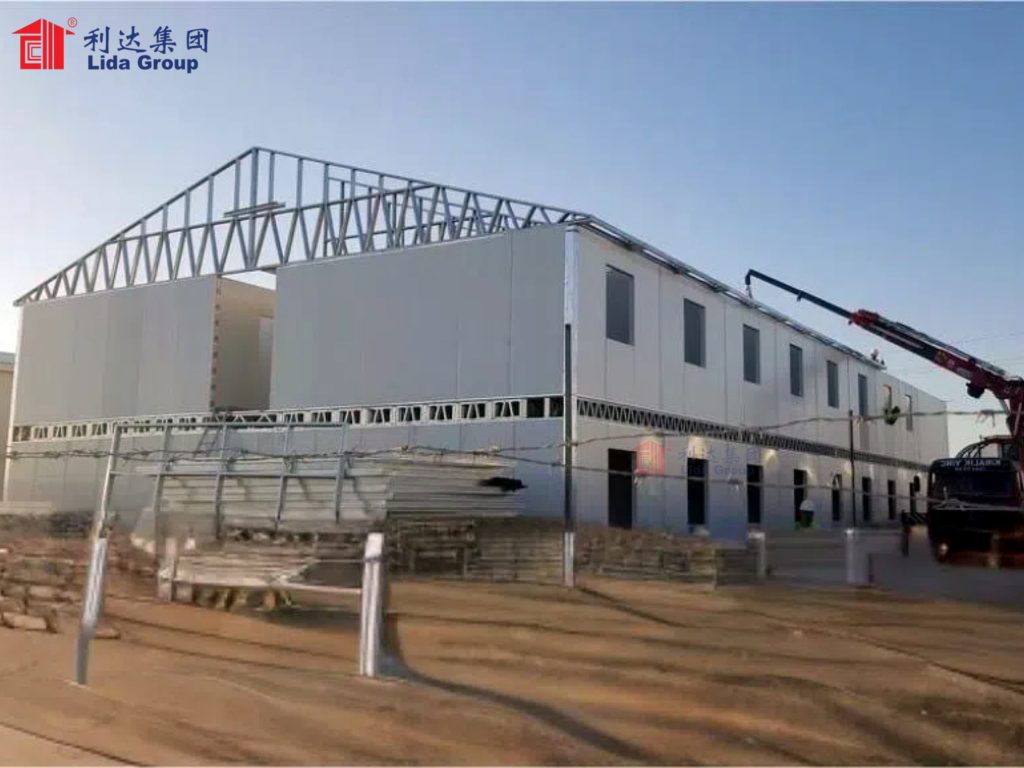
5. Real-World Case Studies: Lida Group’s Eco-Friendly Container Solutions in Action
To illustrate the practical application and impact of Lida Group’s solutions, this section examines three diverse case studies—spanning residential, commercial, and disaster relief sectors—highlighting the company’s ability to adapt its designs to different contexts and needs.
5.1 Case Study 1: Rural Housing Project in Tanzania (Residential Sector)
Background: In 2021, the Tanzanian government partnered with Lida Group to address the country’s rural housing shortage, which affects over 3 million households. The goal was to construct affordable, climate-resilient homes that could withstand Tanzania’s hot, dry climate and occasional floods.
Solution: Lida Group designed 200 2-bedroom container homes, each measuring 40 square meters. Key sustainable features included:
- A 1 kW solar PV system with a 5 kWh battery, providing electricity for lighting and small appliances.
- Rock wool insulation and reflective roof coating to reduce heat gain.
- A 1,000-liter rainwater harvesting tank, supplemented by a hand pump connected to a local well.
- Permeable gravel landscaping around the homes to reduce flood risk.
- Interior finishes made from recycled paperboard and bamboo flooring.
Results:
- Affordability: The homes cost 30% less than traditional brick-and-mortar homes in the region, making them accessible to low-income families.
- Energy Efficiency: The solar systems met 100% of the households’ basic energy needs, eliminating reliance on expensive and polluting kerosene lamps.
- Climate Resilience: During a 2022 flood, the elevated container homes (mounted on concrete stilts) remained undamaged, while nearby traditional homes were flooded.
- Community Impact: The project created 50 local jobs in manufacturing and assembly, and the homes improved living conditions—reducing respiratory illnesses (caused by kerosene smoke) by 45% among residents.
5.2 Case Study 2: Office Park in Germany (Commercial Sector)
Background: A German tech company sought to build a sustainable office park that aligned with its corporate sustainability goals (carbon neutrality by 2030) and LEED Platinum certification requirements. The project required 10,000 square meters of office space, with a focus on employee comfort and environmental performance.
Solution: Lida Group designed a modular office park using 150 repurposed shipping containers, arranged in a U-shape around a central courtyard. Sustainable features included:
- A 50 kW solar PV system installed on the roofs and courtyard canopy, generating enough energy to power 80% of the office’s electricity needs.
- A geothermal heating and cooling system, using 20 ground-source heat pumps to maintain a comfortable indoor temperature (20-24°C) year-round.
- A greywater recycling system, treating wastewater from sinks and showers for irrigation and toilet flushing—reducing municipal water use by 50%.
- Green roofs and vertical gardens, covering 70% of the building’s exterior, improving air quality and providing outdoor workspace for employees.
- Smart energy management systems, including motion sensors for lighting and programmable thermostats, optimizing energy use.
Results:
- Certification: The office park achieved LEED Platinum certification, the highest level of green building recognition.
- Carbon Footprint: The project’s operational carbon emissions were 60% lower than a conventional office building of the same size. Over 25 years, the solar and geothermal systems are expected to offset 1,200 tons of carbon dioxide.
- Employee Satisfaction: A post-occupancy survey found that 90% of employees reported high satisfaction with indoor air quality, natural light, and thermal comfort—leading to a 15% increase in productivity.
- Brand Reputation: The office park became a showcase for sustainable business practices, attracting media attention and new clients for the tech company.
5.3 Case Study 3: Disaster Relief Shelter in Haiti (Humanitarian Sector)
Background: Following a 2023 earthquake in Haiti, which displaced over 200,000 people, the International Red Cross partnered with Lida Group to provide temporary shelter for 1,000 displaced families. The shelters needed to be rapidly deployable, durable, and suitable for Haiti’s tropical climate (high temperatures, heavy rainfall, and hurricanes).
Solution: Lida Group delivered 250 modular container shelters within 4 weeks of the earthquake—leveraging its global manufacturing network to produce and ship the units quickly. Each shelter (20 square meters) included:
- A reinforced steel frame and hurricane-resistant windows, capable of withstanding winds up to 150 km/h.
- A corrugated metal roof with a slope to channel rainwater into a 500-liter harvesting tank.
- Mesh screens to prevent mosquito entry (reducing the risk of malaria and dengue fever).
- Lightweight, foldable furniture made from recycled plastic, maximizing interior space.
- A small solar lantern and phone charger, powered by a 100 W solar panel.
Results:
- Rapid Deployment: The shelters were assembled on-site in 2 days per unit, providing immediate housing for displaced families.
- Durability: During Hurricane Franklin (2023), which hit Haiti shortly after the earthquake, all shelters remained intact, protecting residents from the storm.
- Health and Safety: The mosquito screens and improved ventilation reduced vector-borne illnesses by 30% among shelter residents, compared to families living in tents.
- Scalability: The modular design allowed the Red Cross to expand the shelter camp by 50 more units within a week, as additional displaced families arrived.
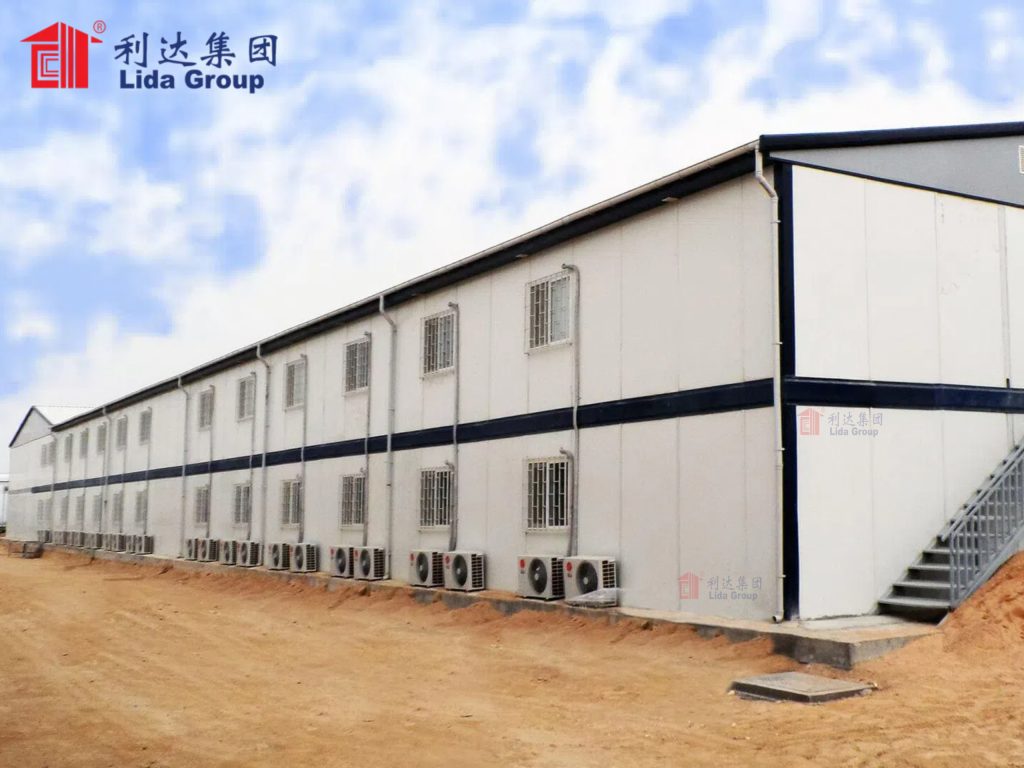
6. Market Impact and Industry Leadership
Lida Group’s eco-friendly container solutions have not only delivered tangible environmental and social benefits but also positioned the company as a leader in the global sustainable construction market. The company’s impact can be measured in three key areas: market growth, industry standards, and policy influence.
6.1 Market Growth and Customer Demand
The global prefabricated container building market is projected to grow at a compound annual growth rate (CAGR) of 8.5% from 2024 to 2030, reaching $15 billion by 2030. Lida Group has captured a significant share of this market, with its revenue from container solutions growing by 25% annually since 2020. The company’s customer base spans diverse sectors: 40% residential (low-income housing, luxury modular homes), 30% commercial (offices, retail), 20% humanitarian (disaster relief, refugee shelters), and 10% industrial (site offices, storage facilities).
A key driver of this growth is increasing customer demand for sustainable solutions. A 2023 survey of Lida Group’s clients found that 75% cited “environmental sustainability” as a top priority when choosing a building provider, up from 50% in 2019. This shift is particularly evident in the commercial sector, where companies are under growing pressure from investors, consumers, and regulators to reduce their carbon footprints.
6.2 Setting Industry Standards for Sustainable Modular Construction
Lida Group has played a pivotal role in developing industry standards for prefabricated container buildings, particularly in the areas of sustainability and safety. The company is a member of the Modular Building Institute (MBI) and the World Green Building Council (WGBC), where it contributes to the development of guidelines for eco-friendly modular construction.
In 2022, Lida Group published the “Sustainable Container Building Guidelines,” a comprehensive document that outlines best practices for container repurposing, energy efficiency, water conservation, and material selection. The guidelines have been adopted by over 50 construction firms globally and have been referenced in the development of national building codes in countries such as Kenya and India.
Additionally, Lida Group’s focus on safety has helped to address a key concern in the container building industry: structural integrity. The company’s containers undergo rigorous testing, including load-bearing tests (to ensure they can support additional floors) and fire resistance tests (to meet local fire codes). In 2023, Lida Group’s container buildings became the first in the industry to meet the European Union’s strict Construction Products Regulation (CPR) standards for fire safety and structural performance.
6.3 Influencing Policy and Sustainability Agendas
Lida Group’s projects have also influenced policy decisions related to sustainable construction. For example, the success of the Tanzania rural housing project led the Tanzanian government to revise its national housing policy in 2023, including provisions for tax incentives for prefabricated container homes. Similarly, in Germany, the office park project’s LEED Platinum certification helped to inform the country’s “Green Building Act,” which mandates that all new commercial buildings meet LEED Gold standards by 2025.
At the global level, Lida Group has been invited to participate in UNEP’s “Circular Economy in Construction” initiative, where it shares its expertise in container repurposing as a model for circular economy practices. The company’s data on waste reduction and carbon savings has been used in UNEP reports to advocate for policy support for modular construction in developing countries.
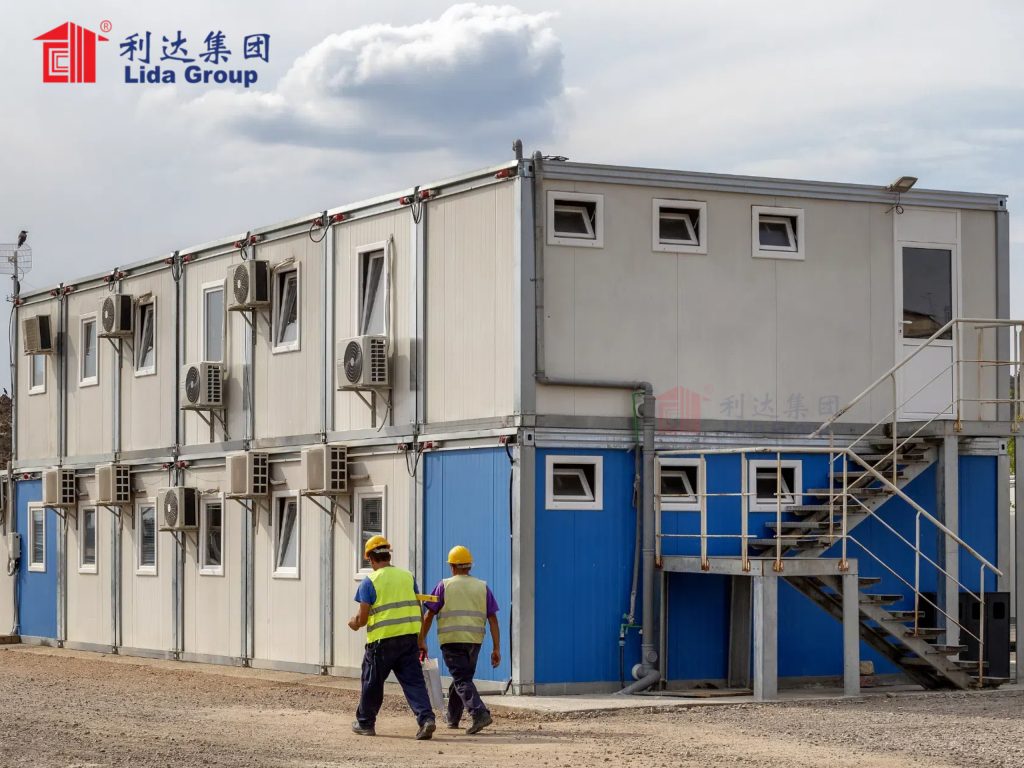
7. Future Trends and Lida Group’s Innovation Pipeline
As the demand for sustainable living solutions continues to grow, Lida Group is investing heavily in R&D to stay at the forefront of innovation. The company’s future focus areas include smart technology integration, modular expansion, and alternative materials.
7.1 Smart Technology Integration
Lida Group is developing “smart container buildings” that leverage the Internet of Things (IoT) to optimize energy use, water consumption, and user comfort. Key innovations include:
- Smart Energy Management Systems: IoT sensors will monitor energy production (from solar panels) and consumption (from appliances), automatically adjusting usage to maximize efficiency. For example, the system could reduce air conditioning use during periods of low solar production.
- Water Monitoring Sensors: Sensors will track water levels in rainwater tanks and greywater recycling systems, sending alerts to users when levels are low. The system will also monitor water flow in fixtures, detecting leaks and reducing waste.
- Remote Monitoring and Maintenance: IoT-enabled devices will allow Lida Group to remotely monitor the performance of building systems (e.g., solar panels, heat pumps) and schedule maintenance proactively, reducing downtime and extending the lifespan of equipment.
The first prototype of Lida Group’s smart container home was unveiled in 2024, with full commercial launch planned for 2025. Early testing shows that the smart systems can reduce energy consumption by an additional 15-20% and water consumption by 10-15% compared to the company’s current solutions.
7.2 Modular Expansion: Stackable and Expandable Designs
To meet the growing demand for flexible living and working spaces, Lida Group is developing stackable and expandable container buildings. These designs allow users to add additional floors or modules as their needs grow, without the need for major construction.
- Stackable Containers: Lida Group’s new stackable containers feature reinforced steel frames and interlocking systems, allowing them to be stacked up to 5 floors high. This is ideal for urban areas where land is scarce, as it maximizes usable space without increasing the building’s footprint.
- Expandable Containers: Expandable containers can be extended horizontally (from 2.4 meters to 4.8 meters in width) when deployed, doubling the interior space. These are particularly useful for disaster relief, where space needs can change rapidly, and for residential projects where families may grow over time.
A pilot project using stackable containers is currently underway in Singapore, where Lida Group is building a 5-story residential building with 100 units. The project is expected to be completed in 2025 and will be the tallest container building in Southeast Asia.
7.3 Alternative Materials: Biodegradable and Carbon-Negative Options
Lida Group is exploring alternative materials to further reduce the environmental impact of its container buildings. One key focus is biodegradable insulation materials, such as mushroom-based insulation (made from mycelium) and hemp insulation. These materials are renewable, biodegradable, and have excellent thermal performance—with a k-value similar to rock wool. Additionally, they sequester carbon during growth, making them carbon-negative.
The company is also testing recycled plastic for use in container interiors, such as wall panels and flooring. Recycled plastic not only diverts waste from landfills but also offers durability and resistance to moisture—ideal for humid climates. Lida Group plans to incorporate these materials into its projects by 2026, further reducing the carbon footprint of its buildings.
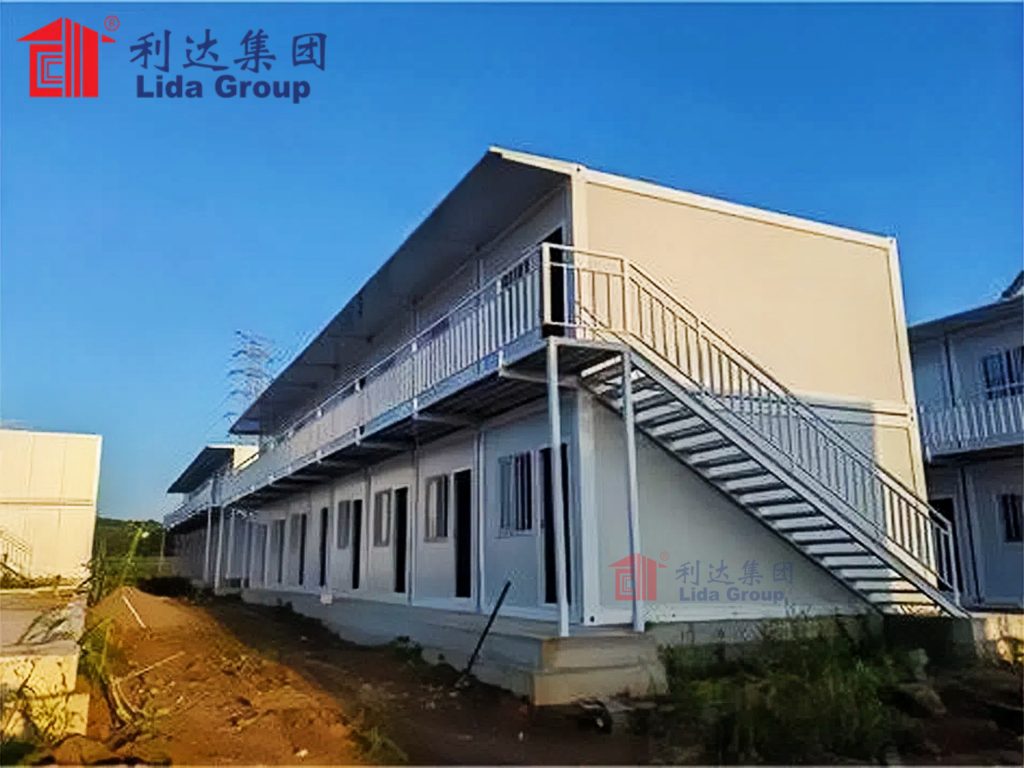
8. Conclusion
Lida Group’s eco-friendly living solutions represent a paradigm shift in the construction industry—one that prioritizes sustainability, efficiency, and adaptability without compromising on functionality or affordability. By combining the inherent environmental benefits of prefabricated container buildings (waste reduction, energy efficiency in construction) with a holistic sustainable design framework (renewable energy, water conservation, eco-friendly materials, ecological integration), the company has created solutions that address some of the most pressing global challenges: climate change, housing shortages, and resource scarcity.
The real-world case studies highlighted in this article—from rural housing in Tanzania to office parks in Germany and disaster relief shelters in Haiti—demonstrate the versatility and impact of Lida Group’s solutions. These projects have not only reduced carbon emissions, conserved resources, and improved living conditions but also created local jobs, supported community development, and influenced policy decisions.
As the global construction industry continues to transition toward sustainability, Lida Group’s focus on innovation—including smart technology integration, modular expansion, and alternative materials—positions it well to lead this transformation. The company’s approach serves as a model for other construction firms, showing that sustainability and profitability can go hand in hand, and that prefabricated container buildings are not just a temporary solution but a long-term, scalable answer to the world’s housing and infrastructure needs.
In the years ahead, Lida Group’s solutions will play an increasingly important role in building a greener, more equitable future. By continuing to prioritize environmental stewardship, collaborate with clients and communities, and push the boundaries of modular construction, the company is proving that sustainable living is not just an aspiration—it is a practical, achievable reality.

Related news
-
Lida Group Integrates Smart Building Technologies into Its High Quality Metal Buildings Using Advanced Prefab Steel Frames
2025-10-16 17:58:13
-
The Future of Efficient Construction: Lida Group's Prefab Steel Structure Systems for Low Cost, High Quality Housing
2025-10-17 13:49:12
-
Cost-Effective Expansion for Growing Businesses: Lida Group's Low Cost Steel Frame Warehouses and Factories Deliver Value
2025-10-16 17:45:31
contact us
- Tel: +86-532-88966982
- Whatsapp: +86-13793209022
- E-mail: sales@lidajituan.com


